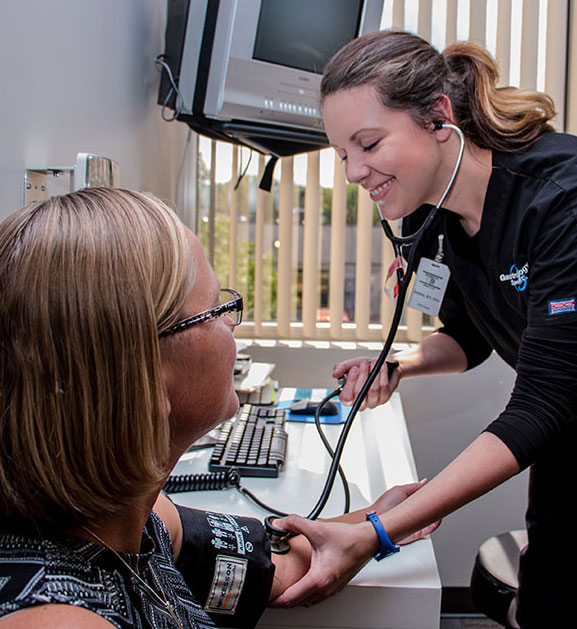You’ve been referred to have an endoscopic ultrasonography, or EUS, which will help your doctor, evaluate or treat your condition. This brochure will give you a basic understanding of the procedure – how it is performed, how it can help, and what side effects you might experience. It can’t answer all of your questions, since a lot depends on the individual patient and the doctor. Please ask your doctor about anything you don’t understand. Endoscopists are highly trained specialists who welcome your questions regarding their credentials, training and experience
What is EUS?
EUS allows your doctor to examine the lining and the walls of your upper and lower gastrointestinal tract. The upper tract is the esophagus, stomach and duodenum; the lower tract includes your colon and rectum. EUS is also used to study internal organs that lie next to the gastrointestinal tract, such as the gall bladder and pancreas.
Your endoscopist will use a thin, flexible tube called an endoscope. Your doctor will pass the endoscope through your mouth or anus to the area to be examined. Your doctor then will turn on the ultrasound component to produce sound waves that create visual images of the digestive tract.
Why is EUS done?
EUS provides your doctor more detailed pictures of your digestive tract anatomy. Your doctor can use EUS to diagnose the cause of conditions such as abdominal pain or abnormal weight loss. Or, if your doctor has ruled out certain conditions, EUS can confirm your diagnosis and give you a clean bill of health.
EUS is also used to evaluate an abnormality, such as a growth, that was detected at a prior endoscopy or by x-ray. EUS provides a detailed picture of the growth, which can help your doctor determine its nature and decide upon the best treatment.
In addition, EUS can be used to diagnose diseases of the pancreas, bile duct and gallbladder when other tests are inconclusive.
Why is EUS used for patients with cancer?
EUS helps your doctor determine the extent of certain cancers of the digestive and respiratory systems. EUS allows your doctor to accurately assess the cancer’s depth and whether it has spread to adjacent lymph glands or nearby vital structures such as major blood vessels. In some patients, EUS can be used to obtain tissue samples to help your doctor determine the proper treatment.
How should I prepare for EUS?
For EUS of the upper gastrointestinal tract, you should have nothing to eat or drink, not even water, usually six hours before the examination. Your doctor will tell you when to start this fasting.
For EUS of the rectum or colon, your doctor will instruct you to either consume a large volume of a special cleansing solution or to follow a clear liquid diet combined with laxatives or enemas prior to the examination. The procedure might have to be rescheduled if you don’t follow your doctor’s instructions carefully.
What about my current medications or allergies?
Tell your doctor in advance of the procedure about all medications that you’re taking and about any allergies you have to medication. He or she will tell you whether or not you can continue to take your medication as usual before the EUS examination. In general, you can safely take aspirin and nonsteroidal anti-inflammatories (Motrin, Advil, Aleve, etc.) before an EUS examination, but it’s always best to discuss their use with your doctor. Check with your doctor about which medications you should take the morning of the EUS examination, and take essential medication with only a small cup of water.
If you have an allergy to latex you should inform your doctor prior to your test. Patients with latex allergies often require special equipment and may not be able to have an EUS examination.
Do I need to take antibiotics?
Antibiotics aren’t generally required before or after EUS examinations. But tell your doctor if you take antibiotics before dental procedures. If your doctor feels you need antibiotics, antibiotics might be ordered during the EUS examination or after the procedure to help prevent an infection. Your doctor might prescribe antibiotics if you’re having specialized EUS procedures, such as to drain a fluid collection or a cyst using EUS guidance. Again, tell your doctor about any allergies to medications.
Should I arrange for help after the examination?
If you received sedatives, you won’t be allowed to drive after the procedure, even if you don’t feel tired. You should arrange for a ride home. You should also plan to have someone stay with you at home after the examination, because the sedatives could affect your judgment and reflexes for the rest of the day.
What can I expect during EUS?
Practices vary among doctors, but for an EUS examination of the upper gastrointestinal tract, your endoscopist might spray your throat with a local anesthetic before the test begins. Most often you will receive sedatives intravenously to help you relax. You will most likely begin by lying on your left side. After you receive sedatives, your endoscopist will pass the ultrasound endoscope through your mouth, esophagus and stomach into the duodenum. The instrument does not interfere with your ability to breathe. The actual examination generally takes between 15 to 45 minutes. Most patients consider it only slightly uncomfortable, and many fall asleep during it.
An EUS examination of the lower gastrointestinal tract can often be performed safely and comfortably without medications, but you will probably receive a sedative if the examination will be prolonged or if the doctor will examine a significant distance into the colon. You will start by lying on your left side with your back toward the doctor. Most EUS examinations of the lower gastrointestinal tract last from 10 to 30 minutes.
What happens after EUS?
If you received sedatives, you will be monitored in the recovery area until most of the sedative medication’s effects have worn off. If you had an upper EUS, your throat might be sore. You might feel bloated because of the air and water that were introduced during the examination. You’ll be able to eat after you leave the procedure area, unless you’re instructed otherwise.
Your doctor generally can inform you of the results of the procedure that day, but the results of some tests will take longer.
What are the possible complications of EUS?
Although complications can occur, they are rare when doctors with specialized training and experience perform the EUS examination. Bleeding might occur at a biopsy site, but it’s usually minimal and rarely requires follow-up. You might have a sore throat for a day or more. Nonprescription anesthetic-type throat lozenges and painkillers help relieve the sore throat. Other potential, but uncommon, risks of EUS include a reaction to the sedatives used; backwash of stomach contents into your lungs; infection; and complications from heart or lung diseases. One major, but very uncommon, complication of EUS is perforation. This is a tear through the lining of the intestine that might require surgery to repair.
The possibility of complications increases slightly if a deep needle aspiration is performed during the EUS examination. These risks must be balanced against the potential benefits of the procedure and the risks of alternative approaches to the condition.
Additional Questions?
If you have any questions about your need for EUS, alternative approaches to your problem, the cost of the procedure, methods of billing or insurance coverage, do not hesitate to speak to your doctor or doctor’s office staff about it.
ASGE – The Source for Colonoscopy and Endoscopy
IMPORTANT REMINDER: The preceding information is intended only to provide general information and not as a definitive basis for diagnosis or treatment in any particular case. It is very important that you consult your doctor about your specific condition. Copyright © 2004 American Society for Gastrointestinal Endoscopy. All rights reserved.


